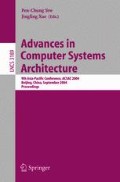Abstract
Asynchronous circuit design is very attractive as a high performance design method since it can achieve average-case delay. However, it is hard to make use of such an advantage in a pipelined architecture due to the blocking/starvation effects between stages. In most of current solutions, buffers are allocated to reduce the blocking/starvation effects but it is difficult to find a distribution of buffers over an asynchronous linear pipeline(ALP) that is optimal in terms of ‘time*area’ cost.
In this paper, we show that the design space of the buffer allocation on an ALP is non-convex by introducing a term, called additional cycle time reduction (ACTR) that can separate the effect of a simultaneous buffer insertion from an individual buffer insertion. Furthermore, we propose a hybrid algorithm such that hill-climbing search is first performed during the early stage of buffer allocation while more sophisticated simulated annealing is applied for the later stage. Such a hybrid approach makes use of the characteristics of buffer allocation design space. Experiments and comparison with conventional methods based on simulated annealing are presented to show the efficiency of the proposed algorithm.
Access this chapter
Tax calculation will be finalised at checkout
Purchases are for personal use only
Preview
Unable to display preview. Download preview PDF.
References
Nilsson, N.J.: Principles of Artificial Intelligence. Springer, Heidelberg (1980)
Williams, T.E.: Analyzing and improving the latency and throughput performance of self-timed pipelines and rings. In: Proc. of International Symposium on Circuits and Systems, May 1992, vol. 2, pp. 665–668 (1992)
Greenstreet, M.R.: STARI: A Technique for High-Bandwidth Communication. PhD. Thesis, Princeton University (January 1993)
Hauck, S.: Asynchronous Design Methodologies: an Overview. Proceedings of the IEEE 83(1), 69–93 (1995)
Kearney, D.: Performance Evaluation of Asynchronous Logic Pipelines with Data Dependant Processing Delays. In: Proc. of the Second Working Conference on Asynchronous Design Methodologies, London, May 1995, pp. 4–13 (1995)
Kearney, D., Bergmann, N.W.: Bundled Data Asynchronous Multipliers with Data Dependent Computation Times. In: Proc. of International Symposium on Advanced Research in Asynchronous Circuits and Systems, April 1997, pp. 186–197 (1997)
Nowick, S.M., Yun, K.Y., et al.: Speculative completion for the design of highperformance asynchronous dynamic adders. In: Proc. of International Symposium on Advanced Research in Asynchronous Circuits and Systems, April 1997, pp. 210–223 (1997)
Chou, W.C., Beerel, P.A., et al.: Average-case optimized technology mapping of one-hot domino circuits. In: Proc. of International Symposium on Advanced Research in Asynchronous Circuits and Systems, April 1998, pp. 80–91 (1998)
Kearney, D.: Theoretical Limits on the Data Dependent Performance of Asynchronous Circuits. In: Proc. of International Symposium on Advanced Research in Asynchronous Circuits and Systems, April 1999, pp. 201–207 (1999)
Sait, S.M., Youssef, H.: Iterative Computer Algorithms with Applications in Engineering. IEEE Computer Society Press, Los Alamitos (1999)
Greenstreet, M.R., Alwis, B.: How to Achieve Worst-Case Performance. In: Proc. of International Symposium on Advanced Research in Asynchronous Circuits and Systems, March 2001, pp. 206–216 (2001)
Chang, C.-C., Cong, J., Pan, Z., Yuan, X.: Multilevel Global Placement With Congestion Control. IEEE Tranc. on Computer-Aided Design of Integrated Circuits and Systems 22(4), 395–409 (2003)
Author information
Authors and Affiliations
Editor information
Editors and Affiliations
Rights and permissions
Copyright information
© 2004 Springer-Verlag Berlin Heidelberg
About this paper
Cite this paper
Lee, JG., Kim, E., Lee, JA., Paek, E. (2004). Efficient Buffer Allocation for Asynchronous Linear Pipelines by Design Space Localization. In: Yew, PC., Xue, J. (eds) Advances in Computer Systems Architecture. ACSAC 2004. Lecture Notes in Computer Science, vol 3189. Springer, Berlin, Heidelberg. https://doi.org/10.1007/978-3-540-30102-8_48
Download citation
DOI: https://doi.org/10.1007/978-3-540-30102-8_48
Publisher Name: Springer, Berlin, Heidelberg
Print ISBN: 978-3-540-23003-8
Online ISBN: 978-3-540-30102-8
eBook Packages: Springer Book Archive

